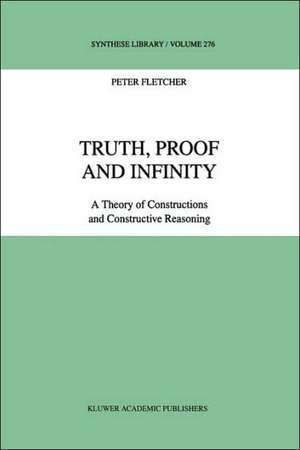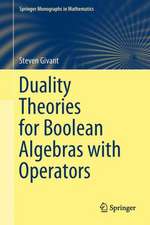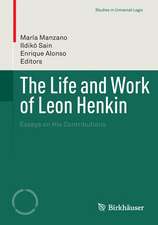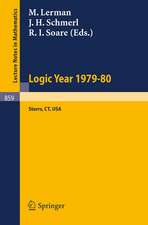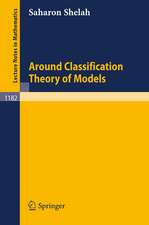Truth, Proof and Infinity: A Theory of Constructive Reasoning: Synthese Library, cartea 276
Autor P. Fletcheren Limba Engleză Hardback – 31 oct 1998
The philosophical basis of constructivism is explored thoroughly in Part I. The author seeks to answer objections from platonists and to reconcile his position with the central insights of Hilbert's formalism and logic.
Audience: Philosophers of mathematics and logicians, both academic and graduate students, particularly those interested in Brouwer and Hilbert; theoretical computer scientists interested in the foundations of functional programming languages and program correctness calculi.
| Toate formatele și edițiile | Preț | Express |
|---|---|---|
| Paperback (1) | 1116.57 lei 6-8 săpt. | |
| SPRINGER NETHERLANDS – 7 dec 2010 | 1116.57 lei 6-8 săpt. | |
| Hardback (1) | 1122.42 lei 6-8 săpt. | |
| SPRINGER NETHERLANDS – 31 oct 1998 | 1122.42 lei 6-8 săpt. |
Din seria Synthese Library
- 15%
 Preț: 638.43 lei
Preț: 638.43 lei - 18%
 Preț: 989.98 lei
Preț: 989.98 lei - 15%
 Preț: 596.69 lei
Preț: 596.69 lei - 18%
 Preț: 903.93 lei
Preț: 903.93 lei - 15%
 Preț: 586.88 lei
Preț: 586.88 lei - 15%
 Preț: 696.50 lei
Preț: 696.50 lei - 18%
 Preț: 892.90 lei
Preț: 892.90 lei - 15%
 Preț: 643.34 lei
Preț: 643.34 lei -
 Preț: 282.33 lei
Preț: 282.33 lei - 5%
 Preț: 372.19 lei
Preț: 372.19 lei -
 Preț: 443.10 lei
Preț: 443.10 lei - 15%
 Preț: 637.59 lei
Preț: 637.59 lei - 18%
 Preț: 958.88 lei
Preț: 958.88 lei - 15%
 Preț: 642.36 lei
Preț: 642.36 lei - 18%
 Preț: 1230.66 lei
Preț: 1230.66 lei - 15%
 Preț: 642.83 lei
Preț: 642.83 lei - 18%
 Preț: 1000.39 lei
Preț: 1000.39 lei -
 Preț: 389.70 lei
Preț: 389.70 lei - 15%
 Preț: 637.28 lei
Preț: 637.28 lei - 18%
 Preț: 952.26 lei
Preț: 952.26 lei - 18%
 Preț: 1231.32 lei
Preț: 1231.32 lei - 15%
 Preț: 645.96 lei
Preț: 645.96 lei -
 Preț: 395.85 lei
Preț: 395.85 lei -
 Preț: 400.47 lei
Preț: 400.47 lei - 18%
 Preț: 1225.48 lei
Preț: 1225.48 lei - 15%
 Preț: 638.89 lei
Preț: 638.89 lei - 18%
 Preț: 1232.09 lei
Preț: 1232.09 lei -
 Preț: 380.45 lei
Preț: 380.45 lei -
 Preț: 394.87 lei
Preț: 394.87 lei - 15%
 Preț: 640.37 lei
Preț: 640.37 lei - 15%
 Preț: 639.08 lei
Preț: 639.08 lei -
 Preț: 381.98 lei
Preț: 381.98 lei - 15%
 Preț: 643.00 lei
Preț: 643.00 lei - 15%
 Preț: 672.29 lei
Preț: 672.29 lei
Preț: 1122.42 lei
Preț vechi: 1368.80 lei
-18% Nou
Puncte Express: 1684
Preț estimativ în valută:
214.80€ • 222.89$ • 179.54£
214.80€ • 222.89$ • 179.54£
Carte tipărită la comandă
Livrare economică 17-31 martie
Preluare comenzi: 021 569.72.76
Specificații
ISBN-13: 9780792352624
ISBN-10: 0792352629
Pagini: 470
Ilustrații: X, 470 p.
Dimensiuni: 156 x 234 x 27 mm
Greutate: 0.84 kg
Ediția:1998
Editura: SPRINGER NETHERLANDS
Colecția Springer
Seria Synthese Library
Locul publicării:Dordrecht, Netherlands
ISBN-10: 0792352629
Pagini: 470
Ilustrații: X, 470 p.
Dimensiuni: 156 x 234 x 27 mm
Greutate: 0.84 kg
Ediția:1998
Editura: SPRINGER NETHERLANDS
Colecția Springer
Seria Synthese Library
Locul publicării:Dordrecht, Netherlands
Public țintă
ResearchCuprins
1. Introduction and Statement of the Problem.- 2. What’s Wrong with Set Theory?.- 3. What’s Wrong with Infinite Quantifiers?.- 4. Abstraction and Idealisation.- 5. What are Constructions?.- 6. Truth and Proof of Logical Formulae.- 7. The Need for a Theory of Constructions.- 8. Theories of Constructions.- 9. Hilbert’s Formalism.- 10. Open-endedness.- 11. Analysis.- 12. Introduction to Part II.- 13. Design of the Term Language.- 14. The Term Language.- 15. From the Term Language to the Expanded Term Language.- 16. The Expanded Term Language.- 17. The Protological Sequent Calculus.- 18. Commentary on the Protological Axioms and Rules.- 19. From Protologic to Expanded Protologic.- 20. Expanded Protologic.- 21. From Expanded Protologic to the Coding of Trees.- 22. The Coding of Trees.- 23. The Expanded Term Language as a Functional Programming Language.- 24. Introduction to Part III.- 25. From the Coding of Trees to Logic.- 26. Logic.- 27. From Logic to the Calculus of Proof Functions.- 28. Calculus of Proof Functions.- 29. From Calculus of Proof Functions to the Logic of Partial Terms.- 30. Logic of Partial Terms.- 31. From Logic of Partial Terms to Heyting Arithmetic.- 32. Heyting Arithmetic.- 33. From Heyting Arithmetic to Peano Arithmetic.- 34. Peano Arithmetic.- 35. Conclusions on Arithmetic.- 36. Introduction to Part IV.- 37. From Expanded Protologic to the Second-Order Coding of Trees.- 38. The Second-Order Coding of Trees.- 39. From the Second-Order Coding of Trees to Second-Order Logic.- 40. Second-Order Logic.- 41. From Second-Order Logic to Second-Order Calculus of Proof Functions.- 42. Second-Order Calculus of Proof Functions.- 43. From Second-Order Calculus of Proof Functions to Second-Order Logic of Partial Terms.- 44. Second-Order Logic of PartialTerms.- 45. From Second-Order Logic of Partial Terms to Second-Order Heyting Arithmetic.- 46. Second-Order Heyting Arithmetic.- 47. From Second-Order Heyting Arithmetic to Second-Order Peano Arithmetic.- 48. Second-Order Peano Arithmetic.- 49. Conclusions on Analysis.- References.- Index of symbols.- Index of axioms, theorems and rules of inference.- Index of names.- Index of topics.
